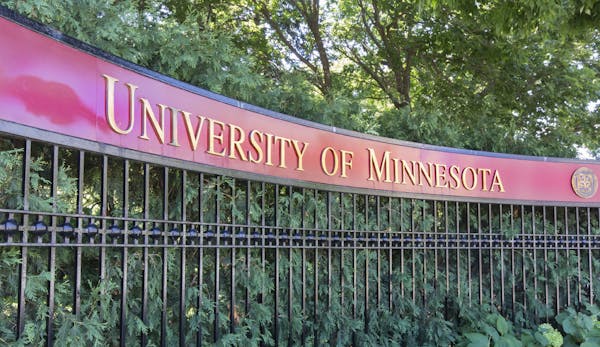Most classes at the University of Minnesota will be taught fully online this fall, even as the school reopens its dormitories, dining halls and campus spaces under some social distancing restrictions.
Of the roughly 8,900 fall classes scheduled so far at the Twin Cities campus, about 70% were slated to be delivered online, according to the U. The rest will be taught either in person or in a hybrid manner, which includes a mix of online and face-to-face instruction.
The fall class lineup solidifies what many in the higher education field have predicted for months: College life during the COVID-19 pandemic will look anything but normal. That reality has left students, professors and some U regents with mixed feelings.
"It's just not going to be the same not being at the U," said Mackenzie Griffin, a junior majoring in economics. With all her fall classes scheduled to be taught online, Griffin opted to cancel her campus housing contract in favor of studying from her parents' home in Baldwin, Wis.
"I am a little mad that they're charging the same for me to go to online school," she added.
As the fall semester inches closer, a clearer picture has emerged of what campus life will look like at the University of Minnesota and other state colleges. Most Minnesota colleges have not strayed from their plans to offer a mix of in-person and online instruction, but some are offering more face-to-face classes than others.
Across the Minnesota State system, 56% of fall classes will be taught in-person or hybrid, officials said last week. At the University of St. Thomas, 76% of classes will have some form of face-to-face instruction, according to officials.
Earlier this month, University of Minnesota Duluth Chancellor Lendley Black told students in an e-mail "some courses will be moving to blended instruction where a portion of the course is delivered both in-person and online. While not every class will be taught face-to-face, students will have access to the courses needed to make progress towards their degree in a number of formats." On Wednesday, UMD officials said they were running the numbers ahead of Thursday's Board of Regents meeting.
In a message to students last week, U President Joan Gabel explained that social distancing guidelines had limited classrooms to a quarter of full capacity.
A classroom meant for 100 students will only fit 25, for example. Administrators worked hard to still offer a mix of courses despite space constraints, she said.
"We also know that some schedules will not perfectly reflect everyone's preferences — and we share your disappointment," Gabel said. "No matter where or how you take your courses or access student services, you will be supported by our preeminent faculty and staff."
About 60% of students on the Twin Cities campus had at least one in-person or hybrid class on their schedule as of Tuesday, according to Rachel Croson, the U's executive vice president and provost.
Instructors were given autonomy in determining how they wanted to teach their classes, and 57% of them have chosen to offer at least one in-person or hybrid course this fall, Croson said.
U pediatrics Prof. Rebecca Shlafer has opted to teach remotely this fall. She said her 20-person, discussion-based class would have been too difficult to hold in a classroom that fits 80, noting that students would have to yell across the room for their classmates to hear them.
Shlafer urged incoming and returning students to temper their expectations for the fall semester.
"The experience you had last fall and the fall before that is not what this is going to look like," Shlafer said.
While classrooms won't be brimming with students, other campus spaces will be open.
Dormitories will be open but limited to single and double occupancy. Students living on campus will have two contracts to choose from: a full-semester housing contract or one that is prorated for a Nov. 25 departure. In-person and hybrid classes will pivot to distance learning after Thanksgiving under the U's fall plan.
Dining halls will offer takeout in addition to limited seating. Libraries and the recreation and wellness center will operate with some modifications. And student groups will be allowed to meet in person so long as they adhere to public health guidance.
Students and faculty will be required to wear masks in classrooms and campus buildings. Instructors will hand masks out to students who enter the classroom without one, officials say. If a student or faculty member repeatedly refuses to wear a mask, they could be disciplined.
"When one violates university policy, there are consequences," Croson told the U's Board of Regents earlier this month.
Regent Steve Sviggum, vice chairman of the board, said he is disappointed there won't be a larger selection of in-person classes for students this fall. He said he and other regents anticipated there would be more when the U announced it would reopen for the fall semester.
"I strongly recognize the new normal we're in. I respect that," Sviggum said. "But it does seem like the numbers are showing a little bit different of a story than I had anticipated."
Regent Michael Hsu expressed concern for students who signed campus housing contracts in hopes of an in-person semester.
"I'm concerned with all the students who are saying, 'Why did you say you were going to open campus? Why am I moving to campus to take all my classes online?' " Hsu said.
Staff writer Brooks Johnson contributed to this report.
Ryan Faircloth • 612-673-4234
Twitter: @ryanfaircloth

A tale of 124 hoarded Minnesota cats has at least a hundred happy endings

Walz, St. Paul leaders urge support for copper wire theft bill: 'We've got to get in front of it'
Body of missing canoeist, 15, recovered from southwest Minnesota lake

High winds flipped a FedEx truck traveling on Bong Bridge in Duluth

